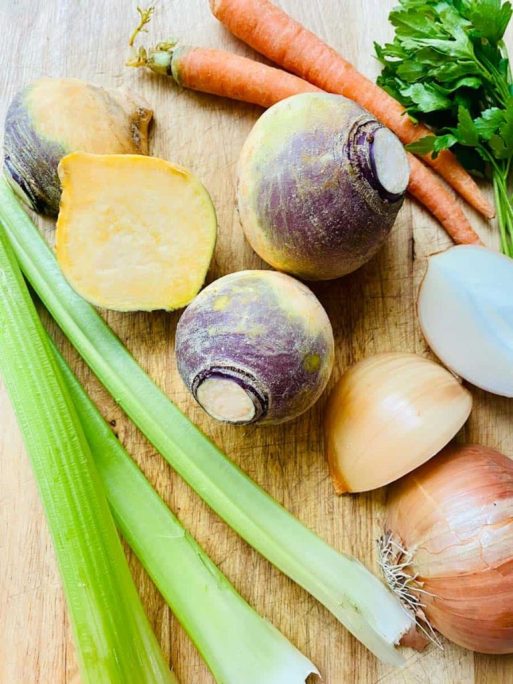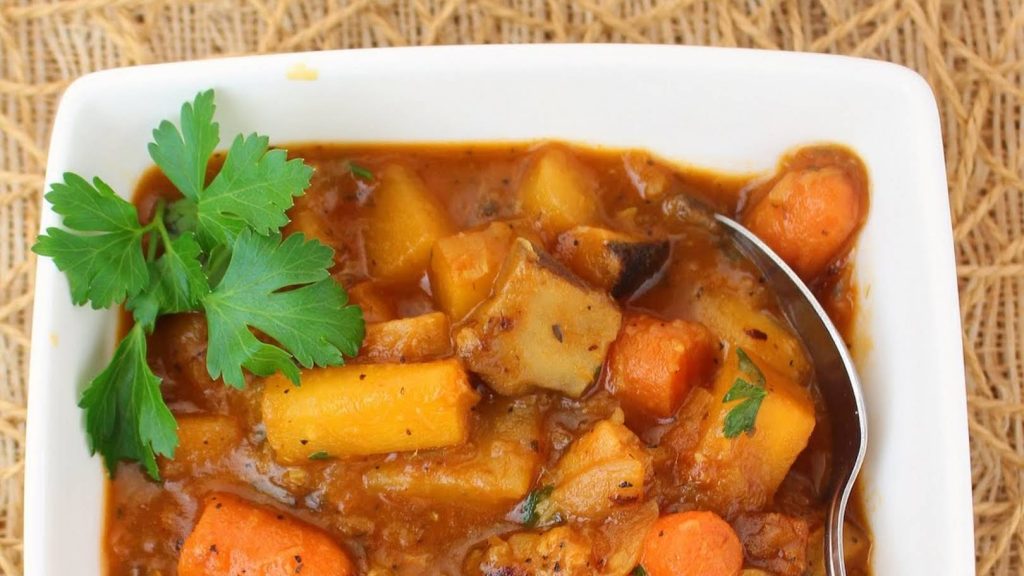This hearty, filling rutabaga soup brings warmth and coziness on chilly winter days. My mom has been making rutabaga soup for years, and I’ve learned that a simple Swedish recipe can be packed with flavor from just a few vegetables. The earthy flavors of roasted rutabaga and carrot blend with onions and garlic to create an incredibly delicious, warming soup. It’s a comfort food classic that’s easy-to-make and doesn’t need any fancy ingredients or fillers—just wholesome, natural vegetable goodness.

After peeling and chopping the root vegetables into small pieces, I add them to a pot with red lentils and a rich vegetable broth. To bring out the ultimate flavor, I let everything simmer until tender, then added a dash of heavy cream before blending it all into a smooth, creamy consistency. This thrifty, inexpensive recipe is a go-to on cold nights and works well with pork, beef, or even venison if you want a more stew-like dish. Although the hardest part is chopping the veggies by hand, the extra effort is well worth it for this flavor-packed and satisfying soup.
What you’ll need to make this rutabaga soup
- 1 large rutabaga (Swede)—peeled and chopped
- 2 carrots – peeled and chopped
- 1 floury potato, peeled and diced
- 1 Granny Smith apple—peeled, cored, and chopped
- 1 large onion (or red onion) – chopped
- 2 stalks celery – chopped
- 3 cloves garlic – minced
- 1-2 tablespoons butter or olive oil for sautéing
-

credit: bettyeatz
Flavorful Additions
- 1/2 cup red lentils – rinsed
- 1 teaspoon fresh rosemary (or 1/2 teaspoon dried)
- 1 bay leaf
- 1/2 teaspoon dried thyme
- 1/4 teaspoon dried oregano
For the Broth
- 4 cups vegetable or chicken stock (use low-sodium if preferred)
- Salt and pepper, to taste
Optional Creaminess and Garnish
-
- 1/2 cup heavy cream or coconut milk – optional, for a creamy finish
- 1/4 cup smoked cheddar – grated, optional, for topping
- Fresh parsley – chopped, for garnish
Directions:
Step 1: Preheat the oven to 400°F. Prepare a baking sheet lined with parchment paper.
step 2: Chop rutabaga, potatoes, carrots, and beets into chunks (about 4 cups in total). Place in a bowl, drizzle with olive oil, sprinkle with salt, and toss to coat.

Step 3: Spread the vegetables on the baking sheet in a single layer. Roast for 40 minutes or until the vegetables are golden and softened at the edges.
step 4: While the vegetables are roasting, heat a Dutch oven or large pot over medium-high and add vegetable oil. Sauté minced garlic, onion, and celery until they turn translucent and softened (1-2 minutes).
step 5: Add red lentils, stock, and a bouillon cube to the pot, along with bay leaves, oregano, and thyme. Pour in enough water to cover the ingredients completely, then reduce to low and let it simmer for about 4 hours. Add more water if needed to keep the ingredients submerged.
step 6: After roasting, add the vegetables to the pot. Blend the soup until smooth with a stick blender or leave some chunks for texture.
step 7: Add a splash of white wine vinegar or apple cider to balance the flavors, and season to taste with pepper and a dash of hot sauce if desired.
step 8: Ladle the soup into serving bowls, sprinkle with fresh parsley, and enjoy warm!

Storing Rutabaga Soup Leftovers
To keep your rutabaga soup fresh and delicious, it’s essential to store it properly. For short-term storage, transfer the hot soup to an airtight container and place it in the fridge once it’s cooled. You can keep it in the refrigerator for 3 to 5 days. When reheating the soup, whether on the stove in a covered pot or in the microwave with a paper towel to prevent splattering, give it a good stir if any liquid has separated. This helps retain its smooth, creamy texture, so it’s ready to enjoy again!
If you’d like to freeze your soup for longer storage, ensure it’s cooled fully, then transfer it to a shallow container. This helps it cool quicker before freezing. For the best results, avoid adding dairy, such as cream or cheese, until reheating to keep the texture unaffected. Once frozen, the soup can last up to a month. When you’re ready to defrost it, heat it on the stove with a splash of water if it’s thickened a bit, giving it a final stir before serving.
What Nutritional Benefits Does Rutabaga Offer?
Rutabagas are packed with beneficial nutrients that make them a healthy addition to your diet. They’re rich in vitamins, minerals, and antioxidants, and they can help control weight, keep your bowels healthy, and even prevent chronic diseases. If you’re looking for a tasty substitute for potato fries, roasted rutabaga chunks are a great alternative—offering all the flavor with added nutrients!
What Makes a Good Rutabaga?
A good rutabaga can elevate the soup’s taste. Rutabagas are in season from October through March but are at their best during the winter months. When choosing a rutabaga, look for one that’s firm, about 4 inches in diameter, with a slight purplish tinge on its skin. This will ensure you have the freshest and most flavorful vegetable to work with.
Can You Eat Rutabaga Skin?
Yes, rutabaga skin is edible, but it can have a stronger flavor than the flesh, especially when it’s larger or bruised. Grocery store rutabagas are often coated in wax for preservation, which makes it tough to cook with the skin on. Personally, I like to remove the skin before cooking for a smoother soup, but you can leave it on if you enjoy that earthy flavor.
What Are the Health Benefits of Rutabaga?
Rutabagas are packed with beneficial nutrients, including vitamins, minerals, and antioxidants. These nutrients help with weight control, support digestive health, and may help prevent chronic diseases. For those looking for a healthy alternative to more caloric vegetables like potatoes, rutabaga is a fantastic choice. Swap them in for potato fries or add them to various recipes for an extra nutrient boost.
Is Rutabaga Hard to Digest?
Rutabaga is similar to its cruciferous cousins like broccoli and cabbage, as it’s high in fiber. Dietary fiber supports digestion by adding bulk to the stool and can help relieve constipation. This means a bowl of rutabaga soup is not only tasty but also great for digestive health!

